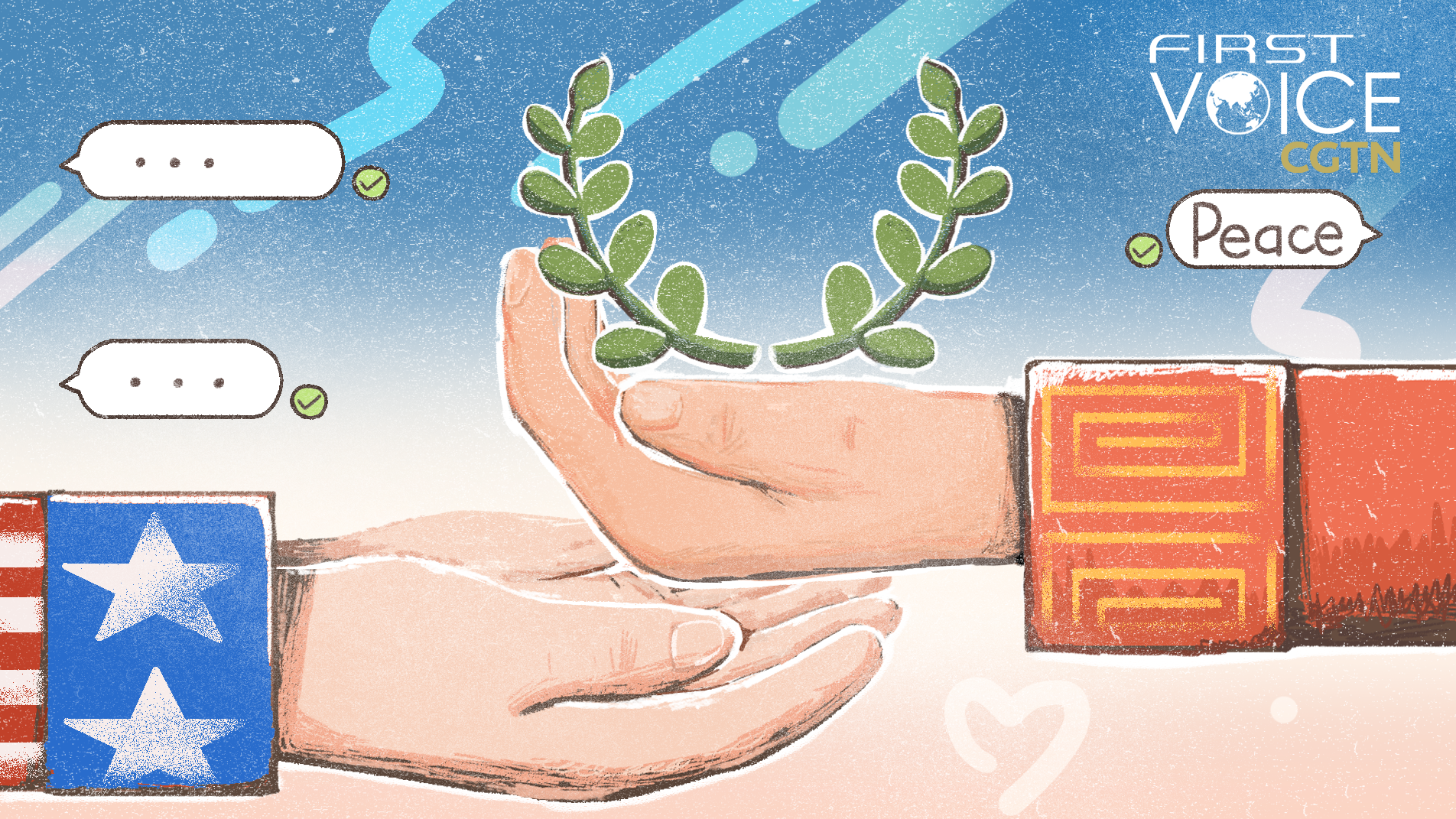
Editor's note: CGTN's First Voice provides instant commentary on breaking stories. The daily column clarifies emerging issues and better defines the news agenda, offering a Chinese perspective on the latest global events.
The U.S. insists on seeing the Ukraine conflict as a high noon shootout between a hero in a white hat and a villain in a black hat.
In reality, Russia and Ukraine need to solve this problem through political negotiations, not on the battlefield. And the U.S. needs to acknowledge its role of pushing the two sides toward conflict instead of talks – a role Washington continues to play with its focus on weapons deliveries to Ukraine and sanctions on Russia instead of discussion and balance.
The video call between Chinese President Xi Jinping and U.S. President Joe Biden shows Washington's addiction to heavy-handed sanctions. Biden not only "detailed" the efforts of "imposing costs" on Russia, according to the White House readout of the call, but also "described the implications and consequences" if China sends "material support" to Russia. This shows that Washington is seeking to end the conflict without making any concessions, or even acknowledging that it played any part in the current crisis. In other words, the primary interest of the U.S. is not protecting the interests or safety of the people of Ukraine, but using the country as a pawn to rack up a Cold War-type victory without losing any American interests.
The United States has been displeased with China's response to the Ukraine conflict, and has sought to drag China into it. However, taking sides right now will only prolong the misery of the Ukrainian people. The only hope for a lasting resolution of the Ukraine crisis must address the two sides' security concerns and be based on the UN Charter, which recognizes the inviolability of the borders of nations including Ukraine.
China, as a neutral party and friend of both Ukraine and Russia, is willing to help both parties move toward peace in any constructive way it can. At the end of the day, a political resolution of the core conflict is the only permanent solution. Any other path to an end of hostilities will be temporary.
The U.S. tried to smear China as being on Russia's side in this conflict, but this is absolutely false. China seeks peace in Europe. A geopolitical victory for either Russia or Ukraine would sacrifice the international system, which is based both on preserving sovereign borders and the principle of indivisible security. Indivisible security means one nation's security cannot be won at the expense of another's. Rather, a balance is needed so all countries can be secure.
The U.S. clearly partly understands this principle – it was the basis of the Cuban Missile Crisis, which brought the world to the brink of nuclear catastrophe. But the U.S. seems to be unable to understand this when the shoe is on the other foot, and its sphere of military influence extends to the borders of a geo-strategic rival.
The U.S. could probably have avoided this entire crisis if it had carried out its promise to Russia that it would not expand NATO to Russia's borders by inviting Ukraine to join. But the U.S., with its maximalist position of no compromise or negotiations, chose to ignore Russia's repeated and clearly stated security concerns, while U.S. experts and scholars have been calling these concerns legitimate.

Ukrainians cross an improvised path along a destroyed bridge as residents continue to flee the city of Irpin, Ukraine, March 8, 2022. /CFP
Ukrainians cross an improvised path along a destroyed bridge as residents continue to flee the city of Irpin, Ukraine, March 8, 2022. /CFP
For the U.S., this conflict has from the start been about asserting dominance and consolidating power – not the wellbeing and safety of Ukrainians. The Ukraine conflict has divided the world along ideological lines like it hadn't seen since the era of the Cold War. This has particularly suited the U.S., which is trying to divide the world into so-called "democracies" and "autocracies" as part of its desperate machinations to remain the world's dominant power.
The U.S. has also used this conflict as a pretext to smear China with lies that it somehow supported or knew about Russia's plans in advance. The U.S. is also laying the groundwork to use this conflict as an excuse to try to further decouple China from the global economy with sanctions — on the completely bogus basis that "China is helping Russia evade sanctions."
It is not within U.S. or Chinese power to impose a certain outcome. The only parties that can bring a lasting peace are those directly involved in the conflict – Russia and Ukraine. There must be negotiations unhindered by outside interests.
China has expressed strong support for the Ukrainian people and emphasized that national borders must be protected under the UN Charter. But China also recognizes that Russia and Ukraine's security concerns must also be balanced, and that can only be done through political negotiations.
The U.S. strategy of exercising maximum pressure and sanctions on Russia, including trying to bully China into giving up its neutrality, will only extend the suffering of Ukrainians on the ground. The U.S. talks as if it cares about the welfare of the Ukrainian people, but at every corner has pushed for dominance rather than peace.
China is willing to play a constructive role in mediating a resolution. And as President Xi made clear to President Biden, the United States and NATO should open up dialogue with Russia to address the crux of the Ukraine conflict and ease the security concerns of both Russia and Ukraine.
The Ukraine crisis is not a story about cowboys in white and black hats to be resolved with a high noon shootout. It requires balance, compromise and mediation by neutral parties.
(If you want to contribute and have specific expertise, please contact us at opinions@cgtn.com. Follow @thouse_opinions on Twitter to discover the latest commentaries in the CGTN Opinion Section.)

